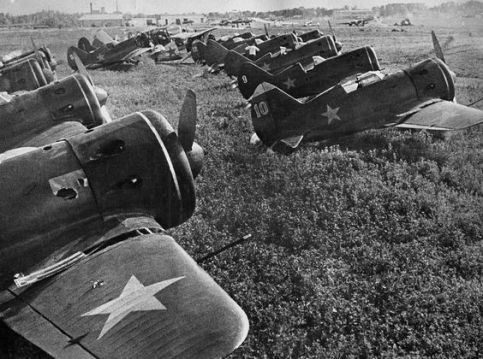[English version at the end]
LAS MÁQUINAS DE “BARBARROJA”
¡Ya a la venta «Barbarroja 03:00 hrs»!
POLIKARPOV I-16 «ИШАК«

El Polikarpov I-16 es el primer diseño de monoplano de caza de gran velocidad que ve la luz en 1933. Interviene en Extremo Oriente contra los japoneses, en la Guerra Civil Española y en la Guerra de Invierno de 1939-40 contra Finlandia. El pequeño Polikarpov I-16 “Ishak” se hace con una reputación de avión tremendamente maniobrero ya antes de la Segunda Guerra Mundial. El “Rata” o “Mosca”, como se le denomina en la Guerra Civil Española (los alemanes aún lo denominarán «Rata» así durante las operaciones en el frente oriental), es aún junto con su antecesor, el I-15, la espina dorsal de la fuerza de caza de la Voenno Vozdushnye Sily (las Fuerzas Aéreas Soviéticas) al comienzo de la campaña. Pero en ese momento ya es un aparato veterano, escasamente rival para los potentes y veloces Messerschmitt.

No obstante, como reza el viejo adagio del combate aéreo, “no es la máquina, sino el hombre”, en manos capaces presenta tenaz oposición contra los aviones del Eje. El mismo Barbarossatag, día 22 de junio de 1941, los aviadores alemanes se empiezan a percatar del fanatismo de algunos pilotos enemigos cuando esa jornada un solitario I-16 “Ishak” arremete deliberadamente contra un Heinkel He-111 en Ucrania. Con terrible regularidad empiezan a darse casos similares en la Blitzkrieg (guerra relámpago) contra Stalin cuando los pilotos soviéticos se quedan sin munición. Es la táctica suicida TARÁN.
Cuatro fábricas en la URSS (nº 39 Moscú, nº 21 Novgorod, nº 153 Novosibirsk y nº 458 Rostov del Don) producirán desde 1934 a 1942 la impresionante cifra de 10.292 unidades. La última variante, el I-16 tipo 29, estará impulsado por un motor Shvetsov M-63 de 1.100 c.v. a nivel del mar, con una velocidad máxima de 470 km/h. a 4.500 metros (nótese que su adversario directo, el Bf-109F, le superará en unos 120 km/h.)
Muchos ases soviéticos, hombres como Safonov, Antonenko o Brinko, adquirirán fama y derribos en la primeras semanas de hostilidades contra el III Reich en el pequeño diseño de Polikarpov. El aparato será utilizado también en el rol de aire-suelo…
¿Te ha resultado de interés este artículo? Deja tu comentario abajo…
¡Adquiere la obra cronológica “Barbarroja 03:00h” en edición de coleccionista!
Sigue interesantes referencias también en Twitter @barbarroja0300h
…………………………………[English version]………………………………
“BARBAROSSA’S” MACHINES
POLIKARPOV I-16 «ИШАК«

The Polikarpov I-16 is the first monoplane high-speed fighter, born in 1933. It sees combat in the Far East against the Japanese, in the Spanish Civil War (1936-39) and in the Winter War against Finland (1939-40). The tiny Polikarpov I-16 “Ishak” gains the reputation of being highly maneuvreable even before World War Two. The “Rata” (Rat) or “Mosca” (Fly), as it was called during the Spanish Civil War (later the name of “Rata” will still be used by the Germans in the Eastern front campaing). It is along with its older brother, the I-15, the fighting workhorses of the Voenno-Vozdushnye Sily, the Soviet Air Force at the start of hostilities. However, it is at that stage a too veteran aircraft, barely a good match for the new powerful and fast Messerschmitts.

Nevertheless, as the old saying goes “it is not the machine, but the man”, in capable hands flies to fight day after day the Axis aviation. On the very same Barbarossatag day, on the 22nd of June’ 41, German aviators start realizing the deadly determination of some enemy pilots when a lone I-16 rams deliberately a Heinkel He-111 bomber in the Ukraine. On a frantic regular basis these cases start happening in the Blitzkrieg (lightning war) against Stalin when the Soviet pilots run out of ammunition. It is the so called suicidal TARAN tactic.
Four factories in the USSR (no. 39 Moscow, no. 21 Novgorod, n0. 153 Novosibirsk and no. 458 Rostov upon Don) will produce between 1934 until 1942 the impressive output of 10,292 units. The last variant, I-16 type 29, will be powered by a Shvetsov M-63 1,100 H.P. engine at sea level, with a speed of 470 km/h. at 4,500 metres (worth noting is its main counterpart’s performance, the Bf-109F, which will overspeed the Polikarpov model by about 120 km/h.).
Many Soviet aces, men like Safonov, Antonenko or Brinko, will acquire fame and aerial victories in the first weeks of the conflict at the controls of the tiny Polikarpov’s design. The machine will also be used in the air-to-ground role…
Did you find this article interesting? Leave your comments below…
Check other entries in Google+ too
Follow other articles in Twitter @barbarroja0300h



Ишак in Russian – is the same thing than a donkey (осел), but this definition is sounds somewhat derogatory and insulting. It can even be used as a derogatory word to man (meaning stupid, stubborn person, or someone who works hard for a small fee)
I wonder why the plane had such a nickname? worked hard and was unpretentious?
Me gustaMe gusta
Thank you for this clarification. As a matter of fact I tried to look for a good translation and it seemed to be «delicate». However, I believe it was a somehow humorous nickname. There are other examples in Aviation: e.g. the Spanish CASA C-101 has the official name «Aviojet», but no one of its pilots call it «Aviojet», but the unofficial name «culo-pollo» (chicken’s ass). Greetings!
Me gustaMe gusta